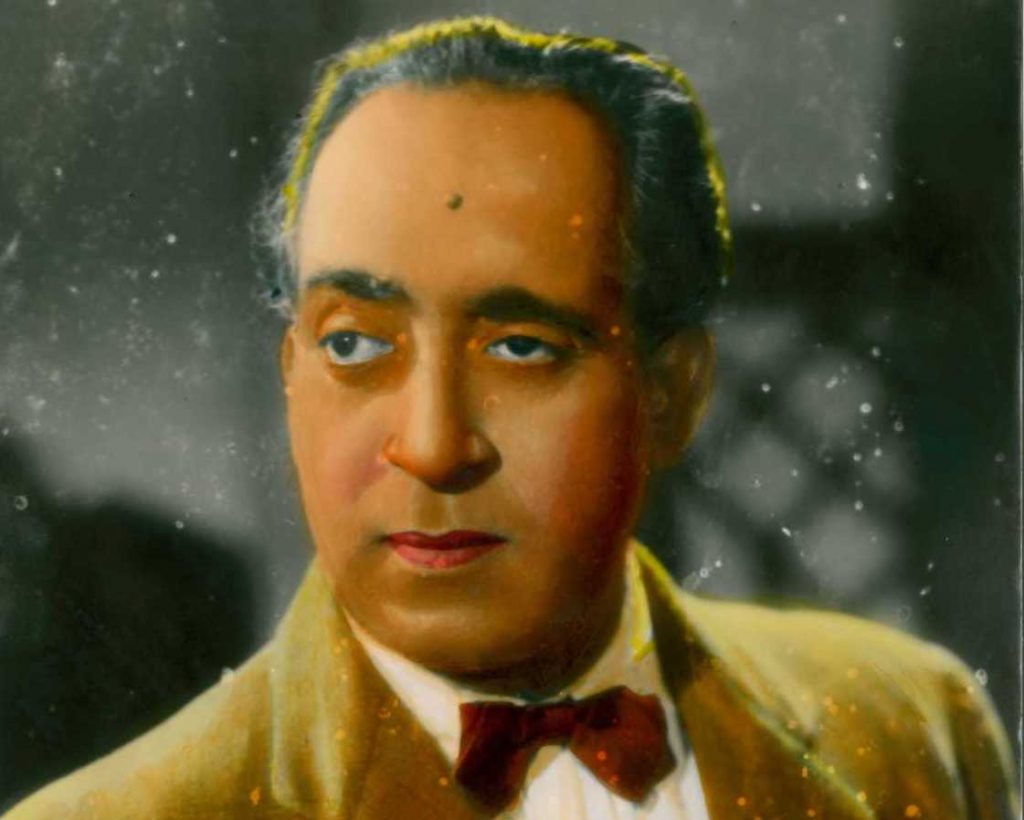KN Singh is still remembered as a top villain of the Hindi film industry, best known for playing extremely sophisticated, suited-booted gentlemen villains, from the late 1930s till the mid 1950s, when he was overtaken by Pran.
He was born Krishna Niranjan Singh on September 1st, 1908 in Dehra Dun in a family of lawyers. But KN Singh was not inetrested in law. Particularly, after he saw his father take up the case of a killer and successfully defend him. He then toyed with joining the Indian army and even turned to sports and was all set to represent India at the Berlin Olympics of 1936 in the shot put and javelin events when a visit to Calcutta to see an ailing sister changed his life forever.
In Calcutta, KN Singh met Prithviraj Kapoor. Prithviraj helped KN Singh with getting started in the film line. Singh met Debaki Bose through Prithviraj and played the role of a doctor in Sunehra Sansar (1936). When a nervous Singh tried running away from the screening of the rushes, Debaki Bose caught him by the hand and told him, “Don’t ever run away from things. You have to face facts.” Singh’s fears were unfounded. His work was much appreciated once the rushes were screen. He was well into his screen journey now.
KN Singh did 4 more films in Calcutta. In Hawai Daku, his second film, for the first and last time in his life he played the hero! He also played roles in the New Theatres films Vidyapati (1937), again being directed by Bose and Anath Ashram (1937) where as the villain he experienced his first ‘screen death’. After Milap (1937), in which he did the role of a prosecuting attorney, AR Kardar brought Singh to Bombay. There he did his major breakthough film with Kardar, Baghban (1938). Singh considers Baghban where he played an evil-minded engineer who woos the heroine as his greatest role ever. Recalling the role he once said, “It was a villain’s role but the violence in it was not physical but subtly mental. I didn’t have to flex my muscles but had to do a lot of intellectual gymnastics.”
In Bombay, KN Singh stayed at Matunga where good friend Prithviraj also lived as did KL Saigal when he came to Bombay to work at Ranjit Movitone. Singh played a villain to Prithviraj’s hero in films like Ek Raat (1942), the directorial debut of WZ Ahmed and Ishara (1943) where he played Prithviraj’s stern father even though he was younger than him! Other important films of KN Singh in the 1940s were Jwar Bhata (1944) where Dilip Kumar made his debut, Draupadi (1944) directed by Baburao Patel and starring Sushila Rani Patel where he played Duryodhan, the Nazir-Swarnalata starrer Laila Majnu (1945), Saigal’s last film, Parwana (1947) and Raj Kapoor’s Barsaat (1949), playing Bholu, a man so ugly that no girl wanted to marry him! Recalling an incident in Laila Majnu where he played Laila’s father, he had to slap Nazir playing Majnu. Nazir insisted for the authenticity of the scene he be slapped properly. KN obliged keeping Nazir out of work for two days!
Two of KN Singh’s best films came in the same year- 1951; Raj Kapoor’s Awara and Guru Dutt’s Baazi. Of course, he was the villain in both. Both were urban films looking at the underbelly of the city. But KN Singh’s roles were as different as chalk and cheese. In Awara he played a dacoit cum street thug while in Baazi he was the sophisticated villain – the goody-goody doctor heroine’s father, a respected man who actually runs a gambling den. KN Singh was particularly fond of his role in Baazi, ranking it alongside the Baghban role. An interesting aside to Awara is that the film was released and extremely popular in Russia as Bradyaga meaning vagabond. Of all the cast members, it was KN Singh who did his own dubbing in Russian! Sadly, a rift with Raj Kapoor never saw the two work again.
Singh made a major impact as a villain in the Hindi film industry. In one of his last interviews he recalled that, “Even off-screen I was a bad man. One day on my way back from shooting, I had to deliver an envelope at an address given to me by my friend. I pressed the doorbell and, from the moving curtains, I could see a woman hurrying to open the door. When she saw me standing in front of her, she screamed out in fright and ran inside leaving the door open. Even I fled from the scene.”
By the mid 1950s, KN Singh was overtaken by Pran as the premier villain of the Hindi film industry. Still, there were films where Singh continued to make his mark as the good old sophisticated villain in films like Milap (1955), Chalti ka Naam Gaadi (1958) and Howrah Bridge (1958). There were also films like Jaal (1952), Funtoosh (1956), CID (1956), Mehlon ke Khwab (1960) and Chhabili (1960) where he played against type and carried off sympathetic roles most effectively.
By the 1970s, KN Singh was playing small cameos in films. And as he grew older, his eyesight became severely impaired and in the last part of his life, he was practically blind. He passed away in Mumbai on 31st of January, 2000, at the ripe old age of 91, having left behind a legacy of more than 200 films and several immortal performances.
On the personal side, having no children of his own, he adopted his brother’s son, Pushkar. Pushkar is a filmmaker in his own right.


